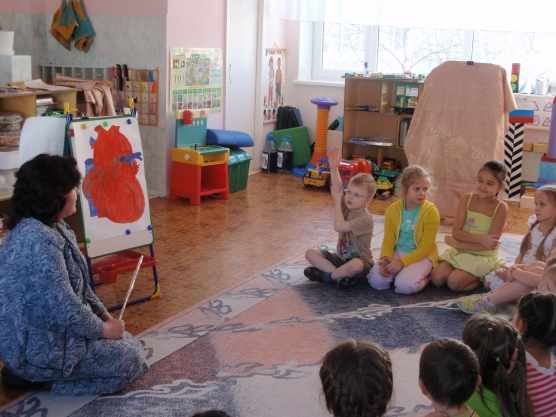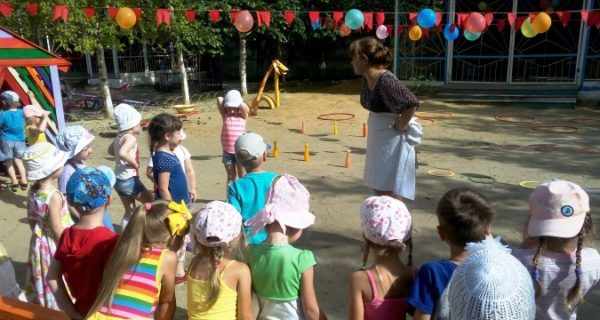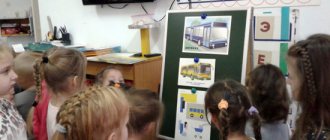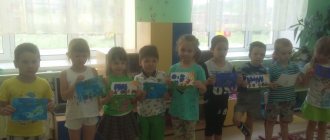Senior group. Senior preschool age. Children 5-6 years old
Summary of GCD for a valeology lesson in the senior group “Skillful Fingers” Valueology lesson on the topic : “Skillful Fingers”
Program content: 1. To form children’s initial knowledge about an important sensory organ - the hand, to continue to introduce them to the functions of the hand and fingers. 2.Develop fine motor skills of the hands, coordination of movements and fingers, deepen and develop.
Publication “Lesson summary on valeology for senior preschool children. » Program content: 1. Give children the concept of sleep; 2. Show the meaning of sleep in a person’s life; 3. Explain to children the physiology of sleep; 4. Familiarize yourself with the basic hygienic rules of sleep. 5. Develop hygiene skills and abilities of children. 6. Cultivate feelings in yourself.
Quest on valeology for children 5–6 years old “Ears, nose and eyes always help us” Web quest on the topic “Ears, nose and eyes always help us. Goal: to form an idea of the role of the senses in the perception of the surrounding world. Objectives: • To introduce children to the senses and their significance for humans. Teach children to make simple conclusions. • Develop.
Synopsis of an educational lesson in the senior group on valeology “Flower of Health” Municipal autonomous preschool educational institution No. 16 “Ryabinka” in the city of Dubna, Moscow region SYNOPSIS OF COGNITIVE LESSON in the senior group on valeology TOPIC: “FLOWER OF HEALTH” (preparing vinaigrette) Teacher of the Highest Qualification Category Shpagina.
Summary of a lesson on valeology in the senior group “The nose, ears and eyes always help us” Topic: “The nose, ears and eyes always help us” Purpose: To give children an idea of the senses as our assistants in understanding the world around us. Objectives: Educational: clarify and consolidate children’s knowledge about the organs of hearing, vision, and smell; expand and deepen knowledge about.
The article “Summary of GCD on valeological education of children 5–6 years old” “In search. » Topic: “In search of the magic flower of Health” Purpose: to consolidate children’s understanding of methods of maintaining health. Objectives: Educational: to reinforce the idea of a healthy lifestyle and the need to take care of your body. Developmental: develop a sustainable interest in.
Abstract of educational activities in valeology using ICT with children of senior preschool age “What we are inside” Summary of direct educational activities in valeology using ICT in senior preschool age. Topic: “What we are like inside.” Prepared and conducted by: E.V. Fedorova, teacher of the preschool educational institution "Ogonyok". G.Nadym 2022 Age group: senior preschool age. Target.
Abstract of the GCD on valeology “Purification of the soul” for older preschool age in the technique of fairy tale therapy “Purification of the soul” Goal: To form in children a conscious desire to be healthy. Objectives: To teach acceptable ways of expressing the removal of negative feelings and emotions. Removing negative moods, restoring strength, developing the ability to cooperate, understand the feelings of others, and provide.
Methodology for developing an open valeological lesson in the senior group
Demonstration lessons are designed not only to demonstrate the level of achievements of children, but also to show the degree of methodological knowledge of the teacher in choosing combinations of methods and techniques for interacting with children. At the same time, both the structure and timing remain unchanged. The main difference is in the design of the content: for an open lesson, the teacher usually uses a plot basis.
Table: Atamanenko O. summary of an open lesson on valeology on the topic “Cleanliness is the key to health” in the senior group (fragments)
| Stage | Content |
| Introductory | Educator: - Children, listen to what happened to me this morning. I’m going to kindergarten, and a little boy runs towards me, dirty, unwashed, unkempt, without outerwear and crying. I stopped him and asked: “What happened? Why are you crying?". Then he told me that all his things were missing and no one wanted to play with him. I calmed him down, said that I would take him with me to kindergarten, tell his story to the children in the group and they, that is, you, would definitely help him. Why do you think this story happened to the boy? Why are his things missing and no one wants to play with him? It seems to me that we have already heard such a story somewhere. In what story did a similar story happen to a boy? (Children’s answers.)…>, |
| <,... - That's right, we read about this in the work “Moidodyr”. Who do you think Moidodyr is? (this is the master of cleanliness and order). So how can we help the boy, what can we advise him? (children's answers). Educator: - Guys, let's tell our guest what needs to be done so that this doesn't happen to him again. We already know that clean water has healing properties. Today we will learn how to use water to clean your body and how to properly care for it. Do you remember what proper care of your body is called? (children answer). Well done, remember: proper body care is called hygiene...>, | |
| Basic | <,... Gryaznulkin: - I really want to learn how to take care of my body. I don't want to walk around dirty anymore. Educator. - Then let's start our lesson, and let's start it with how to properly care for your teeth...>, |
| <,... A child shows on a poster and tells how to brush your teeth. (You need to wet the bristles with water, squeeze the paste onto them from the tube, carefully insert the brush into your mouth, with the bristles with the paste towards your teeth, and begin to slowly brush your teeth, moving the brush up and down, left and right...>, | |
| <,... V. – And now we will learn how to wash our hands correctly. The child recites the poem: “Washing our little hands”: To wash our hands, first we roll up our sleeves...>, | |
| <,...V. So we remembered our first rule of protection against germs. You remembered. G. - Yes! Washing hands with soap. V. - That's right! From simple water and soap, the power of microbes melts...>, | |
| Fixing the material | <,... The game “Apchhi” is played: children are divided into two teams (“Sneezing” and “Infecting”) which disperse at a distance of 5 meters from each other. The “Sneezing” team says “Apchhi!” and throws tennis balls at the opposite team. Children from the “Infected” team must dodge. The one who was hit by the ball leaves the game and begins to “sneeze”...>, |
| The final stage | <,...Gryaznulkin: - Thank you guys... How clean your group has become. And now I will always walk clean and neat. I'm very happy today! That I visited you, Healthy friends. Now I will tell everyone about how you live. “Now I’ll run home to quickly put things in order before my mother returns from work.” V. – Well done today guys, you both remembered and told others how to protect themselves from insidious microbes. |
| https://www.maam.ru/detskijsad/chistota-zalog-zdorovja.html | |
Conducting experiments develops independence in children
Preview:
Developed and conducted by L.V. Yanpolskaya, senior teacher
Purpose: 1. Give children the concept of sleep. Show the meaning of sleep in a person’s life;
Objectives: 1. Explain to children the physiology of sleep; 2. Familiarize yourself with the basic hygienic rules of sleep. 3. Develop hygiene skills and abilities of children. 4. Cultivate a sense of responsibility in yourself so as not to disrupt your daily routine. 5. Activation of the dictionary: Dream bag, clothespins, jug.
Preliminary work: 1. Introduction to bedding. 2. Visit to the laundry room in kindergarten. 3. Exhibition of children's drawings “Magic Dreams”. 4. Children's games with dolls. 5. Selection of folk lullabies: “Tired toys are sleeping” (lyrics by Z. Petrova, music by A. Ostrovsky)
Equipment: 1. Sleep hygiene support charts, 2. illustrated pictures with toiletries, 3. children's beds, 4. dolls, 5. pastels, 6. audio cassettes, 7. art books.
Methodical techniques: 1. Surprise moment; 2. Exhibition of hygiene products; 3. Poems; (S. Marshak “Here under your back”, “Lullaby”, V. Nesterenok “Tricky pillow”, F. Pestryakov “Blizzards are rustling outside the window” 4. Problem situation “Sleep hygiene” 5. Physical exercise; 6. Games; 7. Guessing riddles 8. Summary.
Program content: 1. Give the concept of first aid for sunstroke, heatstroke, fainting, insect bites, bleeding, fractures, poisoning; 2. Introduce artificial respiration techniques, its meaning and necessity. 3. Continue to introduce the circulatory system 4. Nurture the moral and volitional qualities of the individual, mercy, compassion, mutual assistance, mutual assistance. 5. Activation of vocabulary: Artificial respiration, dislocation, proteins, etc.
Preliminary work: 1. Invite the head nurse to the group and talk about first aid, 2. Play the role-playing game “Ambulance”
Equipment: 1. telephone, 2. medical bag, 3. table “Providing first aid; for fractures and dislocations”, 4. scarf, 5. doll, 6. pencil.
Methodical techniques: 1. Surprise moment “Ambulance”. 2. Problem situation “Providing first aid”. 3. Teacher’s story “Medicinal herbs.” 4. Practical “Artificial respiration” 5. Visual “Display of the first aid kit” 6. Physical exercise “Pinocchio”. 7. Games. 8. Summary.
Source
Analysis of a lesson in valeology
Monitoring of work on valeology education is carried out in two formats:
- self-analysis (to identify shortcomings of the organization stage, for example, due to the vastness of valeological issues, the introductory stage may be too drawn out, then the main one is most often crumpled),
- analysis of an open lesson by the guests present - senior teacher, methodologist, manager, colleagues (to determine the level of development of children in the context of valeological knowledge, for example, the ability to maintain cleanliness, awareness of the importance of professions related to saving lives, etc. - and the degree of methodological training of the teacher) .
A diagram of the lesson analysis, as well as an example of self-analysis, can be found here.

Analysis makes it possible to study the effectiveness of the techniques used in the lesson.
Leisure activities on valeology in the senior group
In addition to educational activities, the implementation of the goals and objectives of valeology education in the senior group is carried out through the preparation and conduct of leisure activities, which are held 1–2 times a month. They are usually timed to coincide with holidays (for example, Defender of the Fatherland Day) or the completion of studying a block of topics (for example, about the structure of the human body). The structure of entertainment differs from a regular activity in that the consolidation stage fits organically into the main one. In addition, the timing of the event increases by 5–10 minutes, that is, up to 35–40 minutes.
Among the forms of valeological entertainment practiced in kindergarten, the older group has an advantage for:
- quests,
- KVNami,
- travel,
- fairy tales
This is interesting. Fairy tale scenarios can be found here.
Table: Mizdrenko T.V. scenario for a valeological leisure event on the topic “Travel to health cities” for the senior group
| Stage | Content |
| Introductory | Children line up in a circle. Speech exercise: Teacher: - Hello, girls! Girls: - Hello! Educator: - Hello, boys! Boys: - Hello! Educator: - Hello, guests! Guests: - Hello! Educator: - Hello Sunny! (we raise our hands up) Hello! Hello! (we wave our hands above our heads) We are growing well under the sun (hands up, stretching on our toes) We are becoming healthier every day! (hands to shoulders, to the sides, down) |
| Basic | Educator: - Guys, I want to invite you and our guests to the mysterious land of Health. Our journey will be interesting and unusual; there will be many obstacles and obstacles along the way. This requires endurance, skills, dexterity and mutual assistance. We're leaving. (Music plays, children walk in a circle) |
| (Children approach the first table) The Queen of Glazograd meets the children near the first table: - Hello, children! How were you able to overcome such difficult obstacles? Well done! To find out the name of my city, you must first guess the riddle: Two brothers live across the road, but they don’t see each other. (Eyes)…>, | |
<,... Queen of Glazograd: - It’s so good that we can see, let’s experiment, what can our eyes do?
<,... The conclusion is drawn: We see a multi-colored world with multi-colored eyes. So, our eyes can determine the color, shape, distance and size of objects...>, | |
<,… Gymnastics for the eyes:
| |
| <,... Hygiene and safety rules: Read and draw only in good lighting. In this case, it is necessary that the distance from the table to the eyes be at least 30 cm. After prolonged eye strain, it is recommended to raise your head and look into the distance... | |
| <,...Children continue their journey in Ukhograd and Zubograd...>, | |
| Final | A teacher-doctor gives toothbrushes to children. Educator: - So you’ve returned to kindergarten, I’m glad you’re back. Did you enjoy the trip? The teacher asks questions about the topic of travel and offers to teach their relatives how to do eye exercises, massage the ears and take care of their teeth. |

The main form of creating a script for a leisure activity for middle and older age is theatricalization.
A special place in the educational process of preschool educational institutions is given to the implementation of the tasks of health-saving technologies. One of the forms of their implementation is conducting valeological lessons and leisure activities. In the senior group, these forms of educational activity are aimed at systematizing what has already been learned, as well as building up new knowledge on the existing base.




